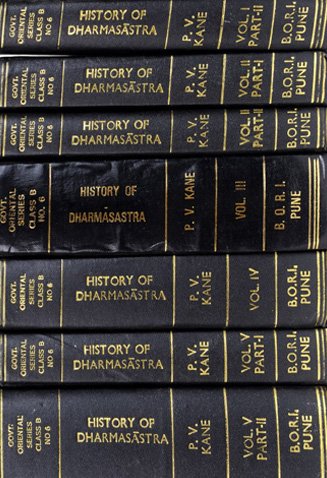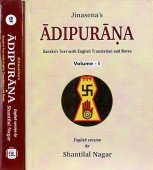Matsyapurana, Matsya-purana, Matsyapurāṇa: 11 definitions
Introduction:
Matsyapurana means something in Hinduism, Sanskrit. If you want to know the exact meaning, history, etymology or English translation of this term then check out the descriptions on this page. Add your comment or reference to a book if you want to contribute to this summary article.
In Hinduism
Purana and Itihasa (epic history)
Source: archive.org: Puranic EncyclopediaMatsyapurāṇa (मत्स्यपुराण).—One of the eighteen Purāṇas. This Purāṇa was told to Manu Satyavrata by Mahāviṣṇu during his incarnation as Matsyu. There are thirteen thousand ślokas in it. For prosperity this Purāṇa should be given as gift on the Viṣuvat day along with a golden image of Matsya. (Chapters 2 and 272, Agni Purāṇa).
Source: Cologne Digital Sanskrit Dictionaries: The Purana IndexMatsyapurāṇa (मत्स्यपुराण).—Originally told by Gadādhara;1 told by Janārdana in the guise of a fish to Manu consisting of a description of Narasimha and an account of the seven kalpas and consisting of 14,000 verses; he who gives it along with a golden fish and a cow on the first day of the Caitra month gets the benefit of the gift of the whole world.2
Source: Shodhganga: Elements of Art and Architecture in the Trtiyakhanda of the VisnudharmottarapuranaMatsyapurāṇa (मत्स्यपुराण) refers to one of the eighteen Major Puranas according to the Matsyapurāṇa and other traditional lists of Puranic literature: a category of ancient Sanskrit texts which gives a huge contribution in the development of Indian literature.—The lists of eighteen Mahāpurāṇas (e.g., matsyapurāṇa) and eighteen Upapurāṇas are not same everywhere, as some names are dropped in some references whereas some are included in others. It can be noticed that, except the Vāyuapurāṇa and the Śivapurāṇa, the names of the Mahāpurāṇas are similar in almost all the Purāṇas.

The Purana (पुराण, purāṇas) refers to Sanskrit literature preserving ancient India’s vast cultural history, including historical legends, religious ceremonies, various arts and sciences. The eighteen mahapuranas total over 400,000 shlokas (metrical couplets) and date to at least several centuries BCE.
Dharmashastra (religious law)
Source: Shodhganga: The saurapurana - a critical study (dharma)Matsyapurāṇa (मत्स्यपुराण) should be donated (dāna) in uttarāyaṇa according to the Dharmaśāstra taught in the 10th century Saurapurāṇa: one of the various Upapurāṇas depicting Śaivism.—Accordingly, the donation of the various Purāṇas to various recipients on different tithis along with the merits thereof are given in the ninth chapter.—[...] Donate the Matsyapurāṇa to a person who has controlled his sense-organs in uttarāyaṇa and be devoid of all sins.

Dharmashastra (धर्मशास्त्र, dharmaśāstra) contains the instructions (shastra) regarding religious conduct of livelihood (dharma), ceremonies, jurisprudence (study of law) and more. It is categorized as smriti, an important and authoritative selection of books dealing with the Hindu lifestyle.
Languages of India and abroad
Sanskrit dictionary
Source: DDSA: The practical Sanskrit-English dictionaryMatsyapurāṇa (मत्स्यपुराण).—Name of one of the eighteen Purāṇas.
Derivable forms: matsyapurāṇam (मत्स्यपुराणम्).
Matsyapurāṇa is a Sanskrit compound consisting of the terms matsya and purāṇa (पुराण).
Source: Cologne Digital Sanskrit Dictionaries: Cappeller Sanskrit-English DictionaryMatsyapurāṇa (मत्स्यपुराण).—[neuter] T. of a Purāṇa.
Source: Cologne Digital Sanskrit Dictionaries: Aufrecht Catalogus Catalogorum1) Matsyapurāṇa (मत्स्यपुराण) as mentioned in Aufrecht’s Catalogus Catalogorum:—[Mackenzie Collection] 44. Io. 406. 407. 1080. Oxf. 38^b. 347^a. 358^a ([fragmentary]). Paris. (B 18). Khn. 30. K. 28. B. 2, 22. 24. Ben. 49. Bik. 203. Kāṭm. 2. Rādh. 40. Oudh. 1877, 14. Viii, 4. Xv, 22. Np. Viii, 20. Burnell. 192^a. Gu. 3. Poona. 340. Ii, 45. 83. Oppert. 96. 8153. Ii, 3223. 4816. 6936. Rice. 76. Mentioned in Kūrmapurāṇa Oxf. 8^a, in Liṅgapurāṇa Oxf. 44^b, in Varāhapurāṇa Oxf. 59^a, in Revāmāhātmya Oxf. 65^b, in Devībhāgavatapurāṇa Oxf. 79^b. Svalpamatsyapurāṇa quoted by Raghunandana in Sāmagavṛṣotsarga. Matsyapurāṇe Ekādaśīvratodyāpanasaṃgraha. Ben. 53.
—Kalpatarudānaprayoga. Ben. 143.
—Kumārastuti. Burnell. 198^b.
—Gosahasradāna. Pheh. 4.
—Taḍāgavidhi. H. 34.
—Tārakavadha. Poona. 386.
—Nadīstotra. Burnell. 199^b.
—Prayāgamāhātmya. K. 26. Burnell. 192^a. Bhk. 14. Peters. 1, 117. 2, 186. Bp. 293. Sb. 240.
—Prayāgāṣṭaka. Printed in Bṛhatstotraratnākara p. 368.
—Bhuvanakośa. Poona. 383. Bhuvanakośe Strīvilāsa. Poona. 403.
—Manvantaravarṇana. Sb. 248.
—Rājadharma. Haug. 52. Burnell. 192^a.
—Vṛṣabhalakṣaṇa. Burnell. 192^a.
—Saubhāgyaśayanavratakathā. Ben. 56.
—Matsyapurāṇakathāpattrāṇi. Bhk. 16.
2) Matsyapurāṇa (मत्स्यपुराण):—Gov. Or. Libr. Madras 63. Rgb. 119 ([fragmentary]). Stein 211. 212.
—[commentary] Bhāvapradīpa, composed by Rāmacandra Bhaṭṭa of Kāśmīr in 1876. Stein 212. Matsyapurāṇe Utpannaikādaśīmāhātmya. L. 4168.
—Airāvatīvarṇana (ch. 109). Stein 212.
—Kṛṣṇāṣṭamīvratodyāpana. Stein 212.
—Devatāsnāpana. Stein 92 (inc.).
—Prayāgamāhātmya. Oudh. Xx, 42. Oxf. 43^b. Stein 212.
—Bhīmasenadvādaśīvratodyāpana. Stein 212.
—Varāhastuti. Fl. 430.
—Vāmanastuti. Fl. 430.
—Śuklāṣṭamīvratodyāpana. Stein 212.
—Satīpratiṣṭhā. Peters. 4, 11.
3) Matsyapurāṇa (मत्स्यपुराण):—Ulwar 847.
4) Matsyapurāṇa (मत्स्यपुराण):—As p. 135 (3 Mss.). 136 (inc.). Bc 260. Bd. 164. Hpr. 1, 264. Io. 406. 407. 1080. 1918. 2032. 2831 (Adhyāyāḥ 1-127). Matsyapurāṇe Ekādaśīmāhātmya. L.. 296.
—Nīlodvāhapaddhati. Ak 375.
—Prayāgamāhātmya. Io. 2320. Jl.
—Śanistotra. L.. 297.
1) Matsyapurāṇa (मत्स्यपुराण):—[=matsya-purāṇa] [from matsya > matsa] n. ‘f°-Purāṇas’, Name of one of the 18 Purāṇas (so called as communicated by Viṣṇu in the form of a fish to the 7th Manu; cf. matsyāvatāra and, [Indian Wisdom, by Sir M. Monier-Williams 512]).
2) Mātsyapurāṇa (मात्स्यपुराण):—[=mātsya-purāṇa] [from mātsya > mātsika] n. = -matsya-p.
[Sanskrit to German]
Sanskrit, also spelled संस्कृतम् (saṃskṛtam), is an ancient language of India commonly seen as the grandmother of the Indo-European language family (even English!). Closely allied with Prakrit and Pali, Sanskrit is more exhaustive in both grammar and terms and has the most extensive collection of literature in the world, greatly surpassing its sister-languages Greek and Latin.
Kannada-English dictionary
Source: Alar: Kannada-English corpusMatsyapurāṇa (ಮತ್ಸ್ಯಪುರಾಣ):—[noun] one of the eighteen major Purāṇas.
Kannada is a Dravidian language (as opposed to the Indo-European language family) mainly spoken in the southwestern region of India.
See also (Relevant definitions)
Partial matches: Matsya, Purana, Puraana.
Full-text (+4481): Candrika, Gardabhi, Sarpakarṇi, Karnamoti, Alambakshi, Shatananda, Mahasuri, Jvalamukhi, Raktakampana, Damshtrala, Bhrukuti, Mahamukhi, Rudrasusata, Rudreshi, Langalavati, Skhalanti, Hunkari, Utpalavartaka, Rakshasi, Kumbhakarni.
Relevant text
Search found 59 books and stories containing Matsyapurana, Matsya-purana, Matsyapurāṇa, Mātsya-purāṇa, Matsya-purāṇa, Mātsyapurāṇa; (plurals include: Matsyapuranas, puranas, Matsyapurāṇas, purāṇas, Mātsyapurāṇas). You can also click to the full overview containing English textual excerpts. Below are direct links for the most relevant articles:
Historical Elements in the Matsya Purana (by Chaitali Kadia)
The concept of Saptadvīpa (seven islands) < [Chapter 4 - Geographical history in the Matsya-Purāṇa]
Niyoga (inviting a widow to remarry) < [Chapter 5 - Cultural history in the Matsya-Purāṇa]
Prostitution in the Matsya Purāṇa < [Chapter 5 - Cultural history in the Matsya-Purāṇa]
The Matsya Purana (critical study) (by Kushal Kalita)
Part 7 - Review of literature < [Chapter 1 - Introduction]
Plotical Aspects in the Purāṇas (Introduction) < [Chapter 6 - Polity in the Matsyapurāṇa]
Part 3 - Date of the Matsyapurāṇa < [Chapter 1 - Introduction]
The Vishnu Purana (by Horace Hayman Wilson)
16. The Matsya Purāṇa < [Preface]
Date of the Purāṇas < [Preface]
Classification of the Purāṇas < [Preface]
Rivers in Ancient India (study) (by Archana Sarma)
3c. The sacred aspect of the river Sarasvatī < [Chapter 5 - Rivers in the Purāṇic Literature]
4a. Sarasvatī’s relation with Brahmā < [Chapter 5 - Rivers in the Purāṇic Literature]
1. Meaning of the term Purāṇa < [Chapter 5 - Rivers in the Purāṇic Literature]
Lord Hayagriva in Sanskrit Literature (by Anindita Adhikari)
Mythological aspect of Hayagrīva in different Purāṇas < [Chapter 4]
Chronological Development (4): Śānti Parva < [Chapter 3]
Table 1: Genealogy of Lord Hayagrīva in the Purāṇās < [Chapter 4]
Manusmriti with the Commentary of Medhatithi (by Ganganatha Jha)
Verse 3.234 < [Section XIV - Method of Feeding]
Verse 7.15 < [Section II - Punishment (daṇḍa)]
Verse 7.63 < [Section V - The Ambassador (dūta)]
Related products

